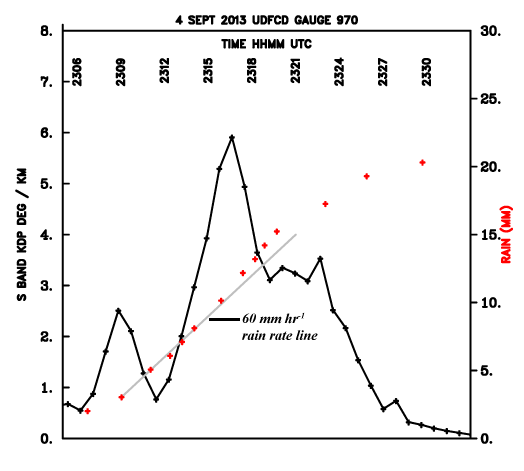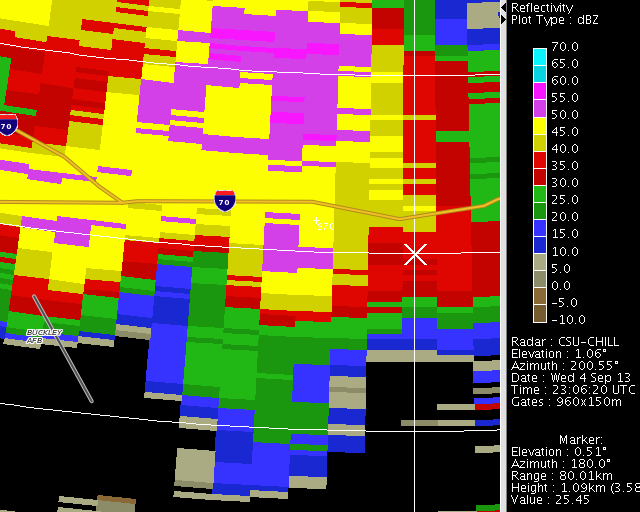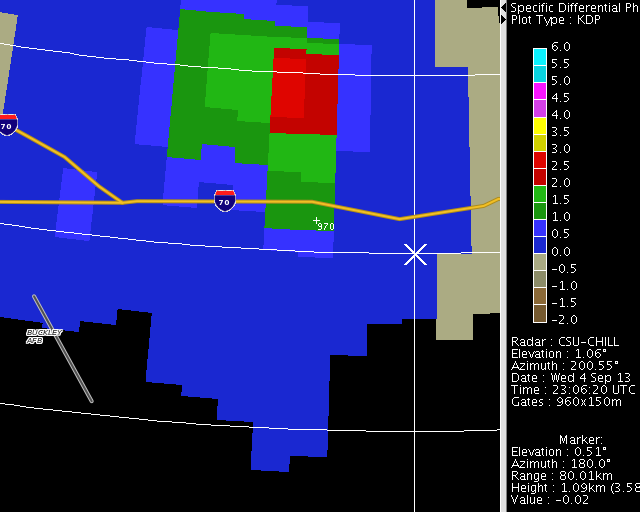Thunderstorm passage over a tipping bucket rain gauge: 4 September 2013: Difference between revisions
Pat kennedy (talk | contribs) No edit summary |
Pat kennedy (talk | contribs) No edit summary |
||
| Line 6: | Line 6: | ||
==Overview== | |||
An isolated thunderstorm that occurred within ~12 km of the southern boundary of Denver International Airport (KDEN) was observed by the CSU-CHILL radar during the late afternoon hours of 4 September 2013. Data collection was done using narrow (40 degree wide) PPI sector scan volumes composed of four elevation angles that ranged from 0.5 to 1.8 degrees. This scan pattern produced a volume repeat time interval of ~52 seconds. A portion of the strong echo core passed over a tipping bucket rain gauge operated by the Denver Urban Drainage and Flood Control District (UDFCD). The location of this gauge (#970 / Aurora Airpark) is shown just inside the 80 km range ring in the following two PPI images. High reflectivity and positive differential reflectivity values typical of heavy rain were over the gauge location at ~2317 UTC: | |||
[[Image:Zh 4sept2013 anot.png|center]] | [[Image:Zh 4sept2013 anot.png|center]] | ||
| Line 14: | Line 16: | ||
==Reflectivity loop== | ==Reflectivity loop== | ||
The following loop is composed of the reflectivity data observed in the 0.5 deg PPI sweeps recorded between 2306:07 and 2333:00 UTC. The signal processor was operating in indexed beam mode, so the individual beam azimuths remain fixed with time. The reflectivity values over the rain gauge maximize at two separate time intervals. A short-lived period of >50 dBZ reflectivity occurred starting in the second loop frame at 2307 UTC followed by a longer duration episode of high reflectivities centered around 2315 UTC. | |||
<center> | <center> | ||
<imgloop delay=300 imgprefix="http://www.chill.colostate.edu/anim/4sept2013_pump_loop/" width=640 height=512> | <imgloop delay=300 imgprefix="http://www.chill.colostate.edu/anim/4sept2013_pump_loop/" width=640 height=512> | ||
| Line 53: | Line 56: | ||
==Specific propagation differential phase loop== | ==Specific propagation differential phase loop== | ||
The next loop shows the specific propagation differential phase (Kdp) data recorded during the same sweeps / times as in the reflectivity loop shown above. The Kdp values also display two peaks that occur in general synchronization with the previously-described reflectivity maxima. The occurrence of high reflectivity and large positive Kdp values are both indicative of significant concentrations of oblate raindrops (i.e., high rain rates). | |||
<center> | <center> | ||
<imgloop delay=300 imgprefix="http://www.chill.colostate.edu/anim/4sept2013_pump_loop/" width=640 height=512> | <imgloop delay=300 imgprefix="http://www.chill.colostate.edu/anim/4sept2013_pump_loop/" width=640 height=512> | ||
| Line 90: | Line 94: | ||
</center> | </center> | ||
==Tipping bucket data== | |||
The next two plots show a combination of the CSU-CHILL S-band reflectivity and Kdp values taken from the single range gate whose location most closely agrees with that of UDFCD gauge 970 and the rain accumulations recorded at each bucket tip. UTC time stamps at three minute intervals are shown across the top of both plot panels. The individual bucket tip data values are shown by red + symbols. The steepness of the line segments defined by the successive bucket tips defines the observed rain rate. The solid line in the following plot shows the reflectivity time history. The two times when reflectivity levels exceeded 50 dBZ are evident: | |||
[[Image:4sept2013 z web.png|center]] | [[Image:4sept2013 z web.png|center]] | ||
The next plot shows the Kdp history combined with the same tipping bucket data points. Rain rates of ~60 mm / hr began to occur ~2 minutes after the initial positive Kdp peak. Rain rates in excess of 60 mm / hr developed shortly after the second, higher magnitude Kdp maximum that occurred around 2317 UTC. The ~60 - 80 mm rain rates implied by the bucket tips are significantly less than the values implied by the Kdp magnitudes. (Using the 40.5(Kdp)**0.85 S-band R(Kdp) estimator yields a rain rate of 159 mm / hr for a 5 deg / km one way Kdp.) This disagreement may be related to the very different atmospheric volumes sampled by the ~12 inch diameter rain gauge funnel vs. the ~ 1.3 km wide pulse volume at a range of 79 km. Also, tipping bucket gauges develop increasingly large under-reporting errors as rain rates increase beyond ~50 mm / hr (Humphrey et al. JTEC 1997, p 1513 - 1519.) | |||
[[Image:4sept2013 kdp web.png|center]] | [[Image:4sept2013 kdp web.png|center]] | ||
==Summary== | |||
Revision as of 16:36, 30 December 2013
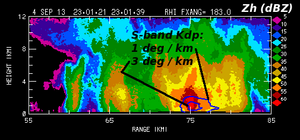
CSU-CHILL S-band data collected in an RHI scan through a thunderstorm that produced high rainfall rates at a tipping bucket rain gauge located 79 km south of the radar. Combined time histories of reflectivity, Kdp, and the rain gauge data have been prepared.
Overview
An isolated thunderstorm that occurred within ~12 km of the southern boundary of Denver International Airport (KDEN) was observed by the CSU-CHILL radar during the late afternoon hours of 4 September 2013. Data collection was done using narrow (40 degree wide) PPI sector scan volumes composed of four elevation angles that ranged from 0.5 to 1.8 degrees. This scan pattern produced a volume repeat time interval of ~52 seconds. A portion of the strong echo core passed over a tipping bucket rain gauge operated by the Denver Urban Drainage and Flood Control District (UDFCD). The location of this gauge (#970 / Aurora Airpark) is shown just inside the 80 km range ring in the following two PPI images. High reflectivity and positive differential reflectivity values typical of heavy rain were over the gauge location at ~2317 UTC:
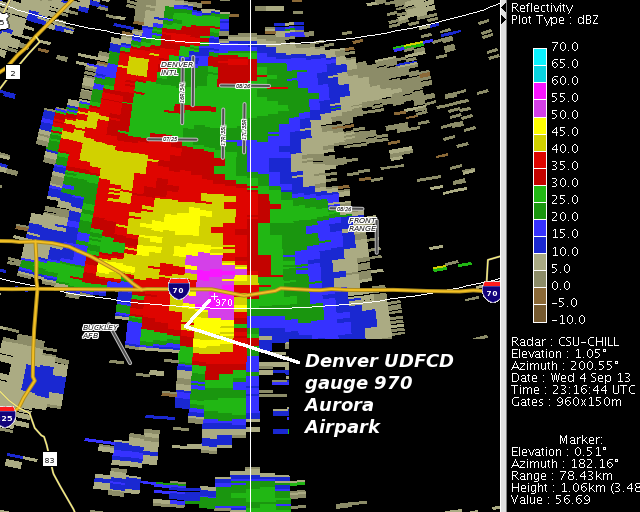
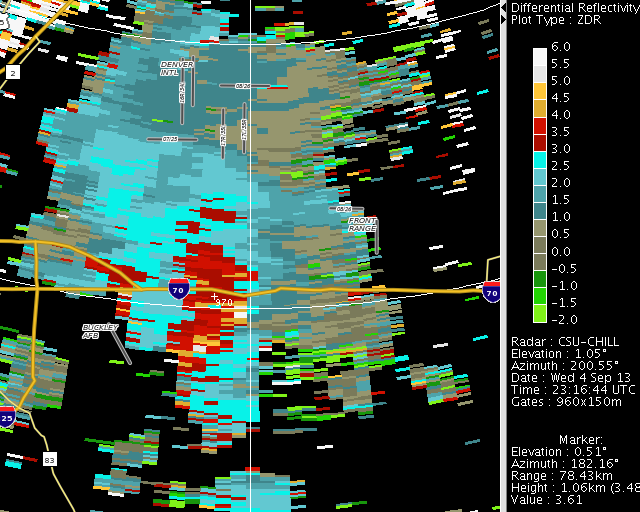
Reflectivity loop
The following loop is composed of the reflectivity data observed in the 0.5 deg PPI sweeps recorded between 2306:07 and 2333:00 UTC. The signal processor was operating in indexed beam mode, so the individual beam azimuths remain fixed with time. The reflectivity values over the rain gauge maximize at two separate time intervals. A short-lived period of >50 dBZ reflectivity occurred starting in the second loop frame at 2307 UTC followed by a longer duration episode of high reflectivities centered around 2315 UTC.
|
|
||
|
Specific propagation differential phase loop
The next loop shows the specific propagation differential phase (Kdp) data recorded during the same sweeps / times as in the reflectivity loop shown above. The Kdp values also display two peaks that occur in general synchronization with the previously-described reflectivity maxima. The occurrence of high reflectivity and large positive Kdp values are both indicative of significant concentrations of oblate raindrops (i.e., high rain rates).
|
|
||
|
Tipping bucket data
The next two plots show a combination of the CSU-CHILL S-band reflectivity and Kdp values taken from the single range gate whose location most closely agrees with that of UDFCD gauge 970 and the rain accumulations recorded at each bucket tip. UTC time stamps at three minute intervals are shown across the top of both plot panels. The individual bucket tip data values are shown by red + symbols. The steepness of the line segments defined by the successive bucket tips defines the observed rain rate. The solid line in the following plot shows the reflectivity time history. The two times when reflectivity levels exceeded 50 dBZ are evident:
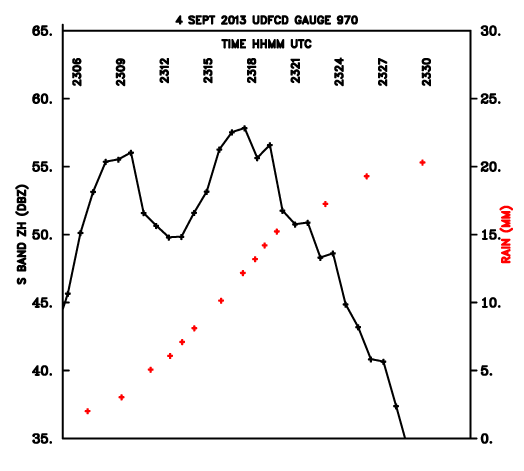
The next plot shows the Kdp history combined with the same tipping bucket data points. Rain rates of ~60 mm / hr began to occur ~2 minutes after the initial positive Kdp peak. Rain rates in excess of 60 mm / hr developed shortly after the second, higher magnitude Kdp maximum that occurred around 2317 UTC. The ~60 - 80 mm rain rates implied by the bucket tips are significantly less than the values implied by the Kdp magnitudes. (Using the 40.5(Kdp)**0.85 S-band R(Kdp) estimator yields a rain rate of 159 mm / hr for a 5 deg / km one way Kdp.) This disagreement may be related to the very different atmospheric volumes sampled by the ~12 inch diameter rain gauge funnel vs. the ~ 1.3 km wide pulse volume at a range of 79 km. Also, tipping bucket gauges develop increasingly large under-reporting errors as rain rates increase beyond ~50 mm / hr (Humphrey et al. JTEC 1997, p 1513 - 1519.)
